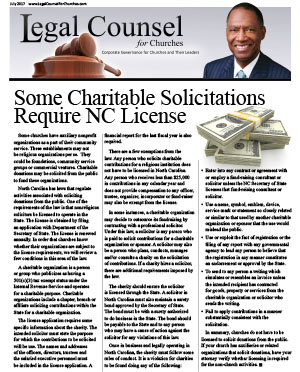Your church has started a negotiation with a potential party. The deal could involve a real estate transaction, new ministry or partnership with another organization. In many of these instances, one party may ask the other to sign a Letter of Intent. Churches should be cautious with this agreement.
A letter of intent is a document where the parties agree to work on an endeavor. Because some deals can be time consuming and costly, parties often use letters of intent to frame the discussions. Further, letters of intent show the parties that each are serious.
The fact that a letter of intent has been introduced means the deal has not been finalized. There are likely details that have not been worked out. This is a time when the parties should be cautious.
There are benefits to having a letter of intent. A well-written letter of intent can greatly reduce misunderstandings. The parties know from the outset the general rules for the negotiations. The letter of intent serves the function of laying out the ground rules.
However, a letter of intent can be risky. If the church is not careful, the letter of intent may inadvertently bind the church to a transaction. Letters of intent also can be confusing to the parties as the essential terms may not have been established.
To avoid the risks of entering into a letter of intent, be sure to insist that all terms be non-binding. Neither the church nor its counterparty wants to be held to any agreement until all of the business and legal points have been fully resolved.
In order to make the letter of intent non- binding, it may not be sufficient alone to simply add a clause to it stating that its terms are non-binding. There can be a chance that a court will rule that the letter of intent is binding if there is evidence that the parties intended it to be binding or either party acted in a way that suggests the agreement was a final commitment.
Generally, the letter of intent should explicitly state at least five conditions:
First, the letter of intent should expressly state there is no intent by either party to be bound. This statement should be unambiguous. There should be no preconditions to this intent.
Secondly, the letter of intent should state that there will be no binding agreement until the transaction itself is finalized and observed by a written contract. While in some instances, a hand-shake agreement is enforceable, complex legal agreements should be recorded in writing. A written contract signals the letter of intent ended.
Thirdly, the letter of intent should provide that all of the essential terms of the transaction have not been settled. The letter of intent often implies the beginning of a negotiation. This should be explicitly stated as such so each party acknowledges some details remain unsettled.
Fourthly, the letter of intent should state that neither party has taken or will take any action in reliance on the non-binding letter of intent. This is very important particularly if third parties are involved. A third party could be induced to act on what they believe is the church’s apparent binding agreement.
Finally, the letter of intent should express that any agreement between the parties is contingent on certain other conditions happening. This provision shows that more work remains to be done before the church accepts the responsibility of a contract.
A church should be aware that, even if the letter of intent contains clear non-binding language, there is still a chance that a court might specifically find the letter of intent is binding if one of the parties expends considerable time and money in reliance on the appearance of a promise.
If your church is faced with signing a letter of intent, it is important that the church officials insist on language to protect their interests. Further, church officials should have a clear understanding of what the church intends to accomplish. Entering into a letter of intent without a plan can be disastrous. Failure to exercise caution with a letter of intent could lead to significant, unanticipated financial liability.

